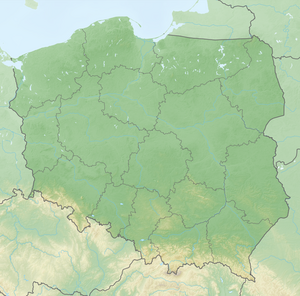Battle of Koniecpol
| date | November 22, 1708 |
|---|---|
| place | Koniecpol , today's Poland |
| output | Victory of the anti-Swedish alliance |
| Parties to the conflict | |
|---|---|
| Commander | |
|
|
|
| Troop strength | |
| 8,000 men | 8,000 men |
| losses | |
|
380 dead, |
200 dead |
1st phase: Swedish dominance (1700–1709)
Riga I • Jungfernhof • Varja • Pühhajoggi • Narva • Pechora • Düna • Rauge • Erastfer • Hummelshof • Embach • Tartu • Narva II • Wesenberg I • Wesenberg II
Arkhangelsk • Lake Ladoga • Nöteborg • Nyenschanz • Neva • Systerbäck • Petersburg • Vyborg I • Porvoo • Neva II • Koporje II • Kolkanpää
Vilnius • Salads • Jacobstadt • Walled Courtyard • Mitau • Grodno I • Olkieniki • Nyaswisch • Klezk • Ljachavichy
Klissow • Pułtusk • Thorn • Lemberg • Warsaw • Posen • Punitz • Tillendorf • Rakowitz • Praga • Fraustadt • Kalisch
Grodno II • Golovchin • Moljatitschi • Rajowka • Lesnaja • Desna • Baturyn • Koniecpol • Weprik • Opischnja • Krasnokutsk • Sokolki • Poltava I • Poltava II
2nd phase: Sweden on the defensive (1710–1721)
Riga II • Vyborg II • Pernau • Kexholm • Reval • Hogland • Pälkäne • Storkyro • Nyslott • Hanko
Helsingborg • Køge Bay • Gulf of Bothnia • Frederikshald I • Dynekilen Fjord • Gothenburg I • Strömstad • Trondheim • Frederikshald II • Marstrand • Ösel • Gothenburg II • Södra Stäket • Grönham • Sundsvall
Elbing • Wismar I • Lübow • Stralsund I • Greifswalder Bodden I • Stade • Rügen • Gadebusch • Altona • Tönning II • Stettin • Fehmarn • Wismar II • Stralsund II • Jasmund • Peenemünde • Greifswalder Bodden II • Stresow
The Battle of Koniecpol on November 22, 1708 was a battle of Charles XII's Russian campaign. in the Great Northern War . It was led between the armies of the Pro-Swedish King of Poland Stanislaus I. Leszczyński and the anti- Swedish supporters of the elected but deposed King of Poland August the Strong, who was deposed in the Peace of Altranstadt . The armies of equal strength fought a losing battle, which 2,000 soldiers of the Leszczyński party paid with their lives.
In advance
The Polish King Stanislaus Leszczyński, supported by the Swedes, wanted to start Charles XII's campaign in Russia with an army of around 8,000 men. support militarily. The allies of the Russian tsar wanted at all costs to prevent this army from uniting with the Swedes. They assembled an army of around 8,000 men and met the Leszczyński supporters near the town of Koniecpol .
The army was under the supreme command of the grand hetmans of the Lithuanian crown Józef Potocki. Leszczyński personally appointed him commander. About 8,000 horsemen and dragoons and a smaller number of artillery were under his command. No infantry units were under his command. The army gathered on November 20, 1708 near the village of Żytno .
This army consisted of two divisions . The first was under the command of the General and Grand Treasurer of Lithuania Jakub Zygmunt Rybiński . It counted 4,400 horsemen and dragoons and 1,200 personal guards of Colonel Sosnowski. The second division was under the command of Ludwik Konstanty Pociejs , his contingent consisted of around 3500 riders.
Grand Hetman Józef Potocki on the side of the Swedish-backed King Leszczyński
General Jakub Zygmunt Rybiński on the side of the alliance against Charles XII.
The battle
The battle began at dawn with light fighting by the cavalry. In the afternoon around 1 p.m. Potocki gave the order to attack. The army of the Poles loyal to Sweden directly attacked the Confederate center. The dragoons had to give way under the heavy gunfire of the enemy lines.
At the same time, Pociej ordered his cavalry, which was on the right wing , to attack the left wing of the Leszczyński army. The left wing collapsed under the attack and retreated in disarray. The Confederates then attacked the right wing, separating it from the rest of the army. Potocki's army was defeated and fled the battlefield.
consequences
Around 400 soldiers of the Leszczyński Army were killed in the battle, and around 1500 more were killed in pursuit by General Rybiński's dragoons. Over 2000 soldiers were captured. Four cannons, three mortars , flags, standards and kettledrums were also captured. There is no information about the dead or injured in the anti-Swedish confederation.
The battle was a military catastrophe for Potocki. Originally his army was planned to support the Swedish king in his Russian campaign. This was no longer possible and thus also weakened the position of Charles XII. in Russia. The loss of this army also weakened Stanislaus Leszczyński's position in Poland. He had hardly any military reserves left, and so it was no problem for August the Strong to get him after the lost Russian campaign of Charles XII. drive out of Poland and regain royal dignity.
Individual evidence
- ↑ a b c d Jean-Baptiste Desroches de Parthenay, p. 247
- ↑ a b c Jean-Baptiste Desroches de Parthenay, p. 246
- ↑ Dorrell, Nicholas. The Dawn of the Tsarist Empire: Poltava & the Russian Campaigns of 1708-1709, Partizan Press (2009). P. 149f
- ↑ Dorrell, Nicholas. The Dawn of the Tsarist Empire: Poltava & the Russian Campaigns of 1708-1709, Partizan Press (2009). P. 149f
literature
- Johannes Philippus Abelin: Historical Chronick or Description of the Strangest History , Volume 3, Frankfurt am Main (1759)
- Jean-Baptiste Desroches de Parthenay: History of Pohlen under the government of Augustus the Second Volume 2, Mietau (1772)


